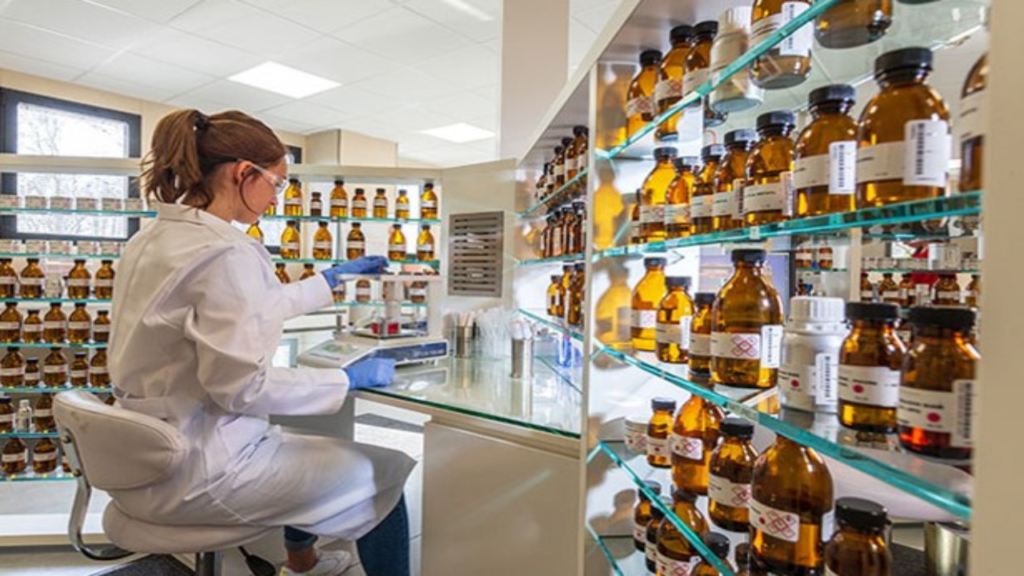Crafting Scents with Art and Precision:
There is art in perfume making, as well as science as perfume making is based on chemistry, biology and sensory psychology. Formulating a perfume mandates knowledge about various components, methods of identifying and isolating the ingredients and how molecules combine to produce the final lasting scent of the perfume.
- Perfume Ingredients: Natural and Synthetic Sources:
Fragrances are produced using numerous constituents from organic origin as well as from chemicals. These ones build the framework or the identity of the fragrance.
Natural Ingredients: Flowers, fruits, spices, woods and resins constitute the natural raw materials used in perfumery business. These ingredients are used for purest quality and aroma only to add this in baking mixtures. Lotus, roses as well as jasmine are familiar; those such as rose, lavender and orchids; while spices such as vanilla and cinnamon give richness and heat. Essential oils or absolutes derived from these natural sources can be extracted by the process of distillation, expression and solvent extraction.
Synthetic Ingredients: Most sud modem perfumes also have other manufactured chemicals, which imitate or reinforce natural smells. Synthetic molecules, for instance, vanillin, and coumarin are central in giving the fragrance as well as stability, compatibility, and availability. Synthetics enable perfumers to create scents that they are not likely to come across, or which can only be sourced with a lot of difficulty.
Animal-Derived Ingredients: As for the ingredients of some traditional perfume, there are uses that come from animals like ambergris, civet, and musk. However, most of these have been replaced by synthetic replicas due to ethical and conservation concerns and these do reproduce the dark, complex and spicy scent that these products provide.
- The Fragrance Pyramid: Notes and Their Roles:
Based on the perfume, there is a system of dividing and interconnecting the scent in the form of a “fragrance pyramid”.
- Top Notes: These are the first impressions which are noticed as soon as it is applied on skin. They are often to be young, fruity or herbaceous, and non-cumulative in nature. Top notes have the first impact and that is why they are so important for attracting attention.
- Middle (Heart) Notes: In the next stage, which is the middle or base note stage, body notes come into the scene and stay in the background to give structure to the perfume. These accords belong to floral, fruity, and spice classes and are supposed to provide harmony and intensity. Heart notes are usually longer in duration than top notes and are the main building blocks of the character of the fragrance.
- Base Notes: Base notes are essential to a perfume since they give depth and have staying power. They appear gradually, for example, when the perfume evaporates, and can persist for hours like slowly fading chromatids. They include deeper scents, the oriental fragrances, such as wood, musk, and resins, which make the fragrance long-lasting.
- The Science of Fragrance Manufacturing:
First, perfume manufacturing is rooted in chemistry because the elements used in making the fragrance will affect each other in response to the other components.
Molecular Composition: Every single ingredient of a scent has individual volatile compounds which seriously affects the time taken for the scent to evaporate and gives off feelings of top, middle and base fragrances. Perfumers have the task of choosing the compounds originating from organic chemistry in order to attain the fragrance with different volatility.
Blending Ratios: The proportions of the ingredients are closely worked out to make sure that scent also has balance and unity. It only takes a tiny change in one component to change the overall scent of the fragrance quite considerably. To achieve this they apply a form of blending known as accord creation where they blend ingredients to produce a unified fragrance that replicates a specific fragrance of a natural substance or offer a brand new experience.
Stabilization: Subsequently, an actual perfume must be stabilized as such a formation requires substantial staying power and will otherwise deteriorate quickly. Mineral spirits are added to comply with evaporation control and fixatives to limit oxidation, whereas antioxidants are added to avoid oxidation. These stabilization steps help to maintain the correct scent for as long as is desired.
- Extraction Techniques: Harvesting Scent from Nature:
In order to produce perfumes crude material, extraction methods are applied which depend on the type of raw material which is to be used.
Distillation: The two main techniques of performing steam distillation are specifically applied on flowers and herbs. It consists of directing steam over the plant material thereby heating it and as a result of the heat, the oils or aroma are released and turned into an oil.
Cold Pressing: Especially for oranges, lemons, grapefruits and other citrus fruit, cold pressing pressurizes the surface of the peel thus liberating the oils. They are effective for making delicate, zesty fragrances Though the name suggests that this is done by means of lights, in actuality, it is done with zest.
Solvent Extraction: Regarding sensitive flowers that can be burned by heat, solvent extraction is applied. This consists of steeping the plant material in a solvent followed by the elimination of the solvent, this is followed by the formation of a highly fragrant substance called an absolute.
CO2 Extraction: This method employs pressurized carbon dioxide as a solvent, the extracts yielded are high quality and this does not apply heat or chemical solvents so as to retain the natural aroma of the plant.
- The Place of Sensory Science and Perception of Smell:
One of the principal ideas of making perfumes is the knowledge of how the human brain is capable of perceiving fragrances. This area of human endeavor is called olfaction or the science of smell and is very important in fragrance development.
Olfactory Receptors: The human nose consists of approximately 400 olfactory neurons which are capable of perceiving millions of diverse odor molecules. When an odor molecule interacts with a receptor, there is a signal to the olfactory bulb in the brain where the odor is analyzed.
Associations and Memory: This is because the sensory organ of smells, the olfactory bulb is responsible for the relay of information directly to the emotional control center of the brain which is the limbic system. The link incurs with perfumers to devise scents which may cause specific thoughts or feelings when using the perfume.
Cultural Influences: The cultural factors also determine prototype scent preferences and patterns. Such a segmentation will entail a differentiation of the smells that can be introduced into the market, say for example, fresh and floral smell may be preferred by the western people as compared to the eastern people who may prefer smells that are related to incense wood. The perfumers then take the above cultural factors into consideration for better management and sustenance of their market.
- PEG Method and Odor Analysis:
Perfume quality and consistency are a subject of paramount importance if the final product must keep the intended scent and develop proper reputation. It entails several testing procedures, as will be discussed in the later sections of this paper.
- Olfactory Testing: Flavorists try out the odor in every step in its production in order to have synergy and accord in a specific fragrance. Flavorists, more often known as professional ‘noses,’ are the final people to offer opinions on the balance, strength, and desirability of a fragrance.
- Stability Testing: Fragrances are subjected to stability tests to determine how the smell of the compound is like under factors that include temperature, light and time. Stability testing helps to understand that the fragrance is preserved and do not fade away inside the bottle.
- Consumer Testing: Normally, brands engage in consumer testing in a bid to determine the market rates of a specific scent. Some of the potential consumers are given samples and how they respond determines the probable performance of the scent.
- The Future of Perfume Science:
The current fragrance business incorporates environmentally friendly strategies to tackle the manner in which natural resources are obtained and the usage of synthetically produced chemical compounds.
Eco-Friendly Ingredients: Some speculative trends are that brands tend to use only responsibly sourced, sustainable raw materials, not using plants which are endangered and using only certified organic ingredients. This shift is important as the customer gains knowledge in conservation of the environment.
Biotechnology and Synthetic Biology: Modern technologies make it possible to produce unproblematic synthetic copies of scarce botanical essences using synthetic biology. For example, companies are making molecules that mimic the smell of flowers or woods using a very cost-effective material: yeast.
Recyclable Packaging: They have also been reducing the waste and pollution levels that are associated with perfume packaging by using recyclable material and user refillable perfume bottles. :This FU originates from lower waste production while satisfying customers with a keen interest in environmental conservation.
Conclusion:
Floristry is a fine art and skill of producing and blending fragrances that involves understanding of chemical reaction and physical apprehension and aesthetics of basic human senses. Each scent differs, and each has captured a mixture of the basic elements of existence, chemistry and the science of psychology. While the perfume industry is becoming more and more environmentally conscious and employ highly technologically means, it still does not forget the fact that the core idea of this industry is to enclose beauty and personality in a bottle. Whether it is in naturally procured or chemically compounded fragrances, perfumes remain to ruffle hearts and stimulate imaginations, and oscillating between the scientific world and creative artistic.

